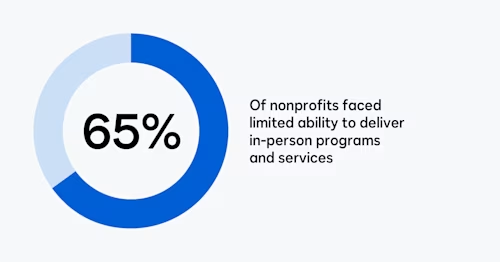
How Nonprofits Use Technology to Manage Modern Programs
See how demand for nonprofit services has increased over time and how electronic signature technology can support nonprofit missions.

Over the last two years, COVID-19 has completely transformed the nonprofit landscape. The pandemic introduced a series of new constraints that forced these organizations to deliver services, collect donations and run day-to-day operations in an entirely new way.
The good news is that nonprofits were able to make necessary changes and survive the sudden shift, but looking forward, leaders see an entirely new playing field that requires an ever deeper transformation. To take the pulse of the industry, Docusign conducted a short survey with U.S.-based nonprofits representing a range of causes.
Nonprofit services are needed more than ever
One of the most prominent obstacles for nonprofits in the last two years has been a dramatic shift in demand, with about three in five organizations reporting increases in demand for their services or activities. That increased demand is here to stay too, with almost three in four nonprofit workers expecting demand to either stay the same or even increase after the pandemic.


Mission delivery requires virtual services
The amount of expected services isn’t the only thing that changed during the pandemic. Today’s nonprofits have had to fundamentally update mission delivery to focus on programs that can be conducted virtually or in a hybrid manner. Our respondents reported around 46% of programs were in-person before COVID-19 and only a third of them were able to transition to virtual delivery during the pandemic.


In order to continue serving their mission effectively, it’s clear that nonprofits need to rethink the way they operate—whether that’s moving to a hybrid delivery model or going all-in on virtual services. Existing programs need to evolve to incorporate more digital interactions and empower employees and volunteers to contribute from anywhere. New programs need to be built with a digital-first approach.
Electronic signature supports modern nonprofit programs
To navigate the move to a virtual environment, nonprofits are investing in new technology. During the COVID pandemic, almost 9 in 10 nonprofits have invested in technology to tackle new problems. As part of that move, 82% of nonprofits say COVID-19 has illuminated the need to invest in electronic signature tools like Docusign eSignature.
Nonprofits have taken big steps to adopt e-signature tools, with more than 80% having at least some degree of digital signature collection. These organizations have made significant progress to collect signatures more digitally, and the early results show improvements in security, ease of use, client experience and a lot more. The benefits improve the overall experience for every party involved. Looking forward, it’s easy to see how this will be the new standard for agreements, especially client intake paperwork.


By improving efficiency in routine agreement processes, nonprofits can save significant amounts of money and time that can be dedicated to other initiatives that contribute to the overall mission. For example, nonprofits save an average of 128 hours of staff time per month by using electronic signature for client intake. With all of the changes required to build a hybrid delivery system, those extra employee resources can go a long way.
Taking the next steps after success with e-signature
It’s encouraging to see nonprofits modernizing with electronic signature adoption. It’s an easy way to keep delivering services to clients amid uncertainty. However, e-signature is only one step in a journey to serve clients better. The challenging landscape they have to navigate—including uncertain funding, increased security risks and a hybrid workforce— requires more than one solution.
Nonprofits that have a long-term focus on hybrid mission delivery, client experience, cost control and fundraising revenue are hitting their goals by investing in agreement technology. By building an integrated system with modern tools at every step, nonprofits can create more efficient workflows, reduce costs and improve security throughout the organization. Connecting e-signature to systems that manage client and donor relationships will centralize paperwork processes across the entire organization.
Docusign for Nonprofits is built for the digital environment that lies ahead. By digitally transforming the agreement process, nonprofits will accelerate their business goals and modernize the experience of clients, staff and donors. With a robust, integrated system of agreement, nonprofits will be positioned for success in the present and the future.

Related posts
Docusign IAM is the agreement platform your business needs



